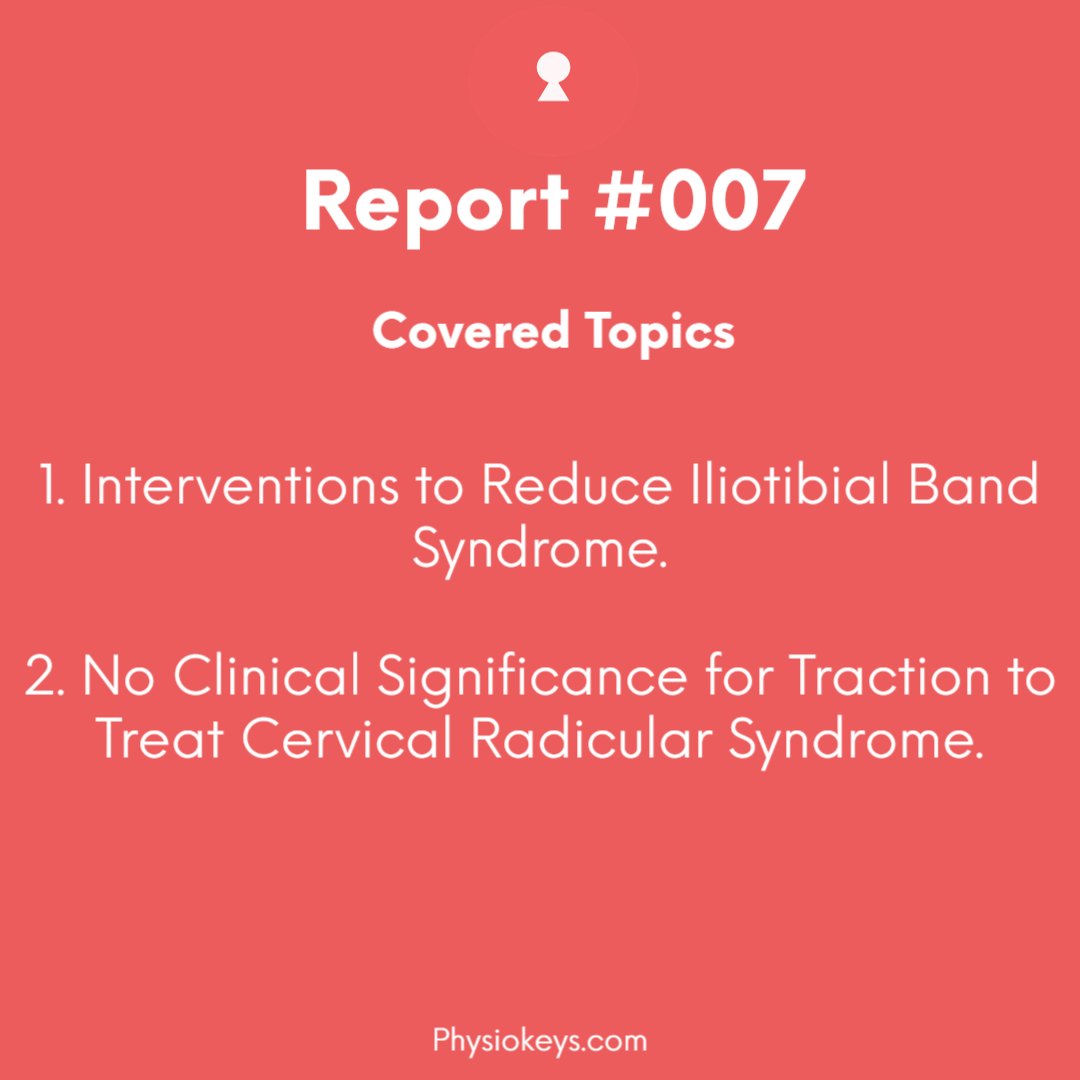#007- Articles on Iliotibial Band Syndrome and CRS.
Covered Topics:
1. Interventions to Reduce Iliotibial Band Syndrome.
2. No Clinical Significance for Traction to Treat Cervical Radicular Syndrome.
Estimated reading time: 2 minutes, 36 seconds.
Articles
Interventions to Reduce Iliotibial Band Syndrome in athletes
This systematic review compared conservative interventions to surgical interventions to treat distal iliotibial band syndrome (ITBS), they included 13 studies with evidence level of Level II and IV studies., 178 athletes received conservative interventions and 200 athletes received surgical intervention.
Physiotherapy related programs:
- Shockwave therapy + standardized exercise program
- Manual therapy + standardized program
- 6-week rehabilitation program to strengthen the hip abductors
- 0-14 days: rest, daily stretching and twice daily ice therapy, 3-14 days: ultrasound treatment.
- Deep transverse frictions.
- Patients that underwent surgery, received conservative interventions for 3 to 6 months before surgery.
Physical examination findings of athletes that had surgeries:
- Tenderness to palpation over the lateral femoral condyle,
- Positive Noble compression test.
- Positive Ober’s test.
- Pain with palpation of the lateral femoral condyle while extending the knee from 90° to 0°.
- Snapping of the distal ITB during a full knee range of motion.
- Maximum pain at 30 degrees of knee flexion while pressure is applied on the lateral femoral condyle during active knee flexion-extension motion (compression test).
- Crepitus over the lateral knee.
- Lateral knee swelling.
Main findings:
- The authors couldn’t preform a formal comparison between conservative and surgical interventions due to significant data heterogeneity.
- There was severe literature inconsistency and low quality of evidence on the outcomes of both groups.
- Conservative therapy was found to reduce pain at short term follow-up maximum of 6 months.
- Surgical interventions were found effective in returning athletes to sport at a rate of 81% to 100%.
- All patients who underwent surgery to address ITBS had previously not responded to conservative treatment.
No Clinical Significance for Traction to Treat Cervical Radicular Syndrome
This systematic review and meta analysis compared traction+ other interventions to other interventions alone in patients with cervical radicular syndrome, which they defined as pain symptoms radiating to one or both arms in a dermatomeric distribution of sensorimotor symptoms due to a conduction deficit and a dynatomeric distribution of pain.
7 Trials that included 589 participant
Main Comparisons:
- Continuous mechanical traction vs sham traction (1 Study):
- No significant difference (low quality evidence).
- Traction+ other Interventions Vs Other Interventions (6 Studies, 405 participant):
- Traction+ other Interventions was significantly effective in reducing pain compared to other interventions alone (low quality evidence).
- Mechanical traction used in six comparisons, manual traction in 2 comparisons.
Secondary comparisons:
- Mechanical traction and Manual traction
- Mechanical Traction was assessed by five studies and included 357 participant,
- Mechanical traction showed statistically different results than control groups. (low quality evidence)
- Manual Traction was assessed by 2 studies and included 48 patients,
- Manual Traction was not statistically different from control groups. (Very low quality evidence)
- There is consistent evidence that mechanical traction is more effective than manual traction.
- Mechanical Traction was assessed by five studies and included 357 participant,
- Continuous Traction and Intermittent Traction
- Continues traction was statistically different from control groups as assessed by 2 studies including 48 participant. (Very low quality evidence).
- Intermittent traction was not statistically different from control groups as assessed by six studies including 345 participant (Very low quality evidence).
The most used technique was continues mechanical traction for 10-25 minute at an angle of 20 to 25 degree of cervical flexion or in the most pain free position, with a load of 2.7 to 15.91 kg.
The results of this article indicate that traction combined with other treatments is superior to other treatments alone, but these results were not clinically relevant according to the authors.
Note
- The traction study results are disappointing, I use manual traction with other techniques, a lot for cervical patient, and it usually helped reduce radiating pain for at least a short period.
Trends
Iliotibial Band Syndrome was most searched by people in Australia, United Kingdom, United States, New Zealand and Ireland, the also searched for Piriformis syndrome.
No data on Cervical Radicular Syndrome, properly because people will search for neck pain ?.
References
- Operative Versus Nonoperative Management of Distal Iliotibial Band Syndrome—Where Do We Stand? A Systematic Review. (Open Access)
- Traction Therapy for Cervical Radicular Syndrome is Statistically Significant but not Clinically Relevant for Pain Relief. A Systematic Literature Review with Meta-Analysis and Trial Sequential Analysis. (Open Access)


